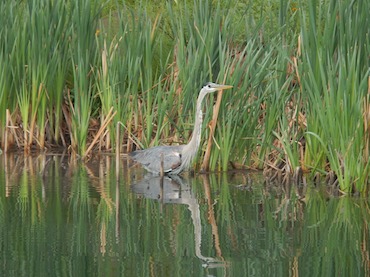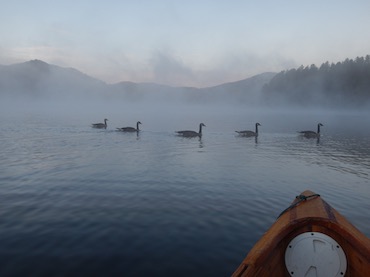Protecting the animals
08/07/16 04:33
I read a report from the BBC website yesterday that reported that biologists in western Iceland are hoping that brightly colored roads could prevent Arctic terns from being hit by traffic. There was a picture with the article of a road that was painted pink and green. The theory is that the bright colors will make the birds more visible to drivers when they are sitting on the road. The birds are attracted to the road surface because it is warm. Young birds are particularly vulnerable to traffic because their feathers are a mottled brown which blends into the traditional paved road surface from a distance. Arctic terns are small birds, weighing only about 3 1/2 ounces. They are hardly a match from a car speeding down the highway. Part of the problem is that traffic is way up from a few years ago as tourism in Iceland has increased quite a bit in recent years. I have some understanding of this if for no other reason than that I would love to visit Iceland myself. The terns themselves are tourists. They migrate from the Arctic to the Antarctic. Scientists at Newcastle University tracked one bird that flew 59,650 miles from the Farne Islands to the Weddell Sea and back. It is the longest bird migration ever tracked by scientists.
I kind of like the idea of pink and green roads. I’m thinking that it is a solution that might never be attempted in the United States. We are more likely to try to figure out ways to keep the birds from going on the road in the first place, claiming the highway as our exclusive domain. In Canada we saw several overpasses made to accommodate game trails. The deer, elk and moose apparently will use a more direct path under the highway when it is provided. It doesn’t eliminate cars hitting the animals, but apparently it decreases the number of such accidents.
Most days when I am paddling I see multiple animals on the road between home and the lake. Early in the morning there are usually deer and turkeys on the road. This time of year, the bucks are often out and about at first light. They have their new antlers and though they don’t have the single-minded focus of the autumn rut, they seem to prefer to strut and don’t like to have to speed up just because a car is coming. There are also plenty of fawns and they are starting to graze with their mothers these days, so that is another reason for caution. When I’m going to the lake I generally am not in a hurry and so I usually avoid hitting animals. In the past, however, I have hit deer on occasion. It always makes me feel bad. I don’t think, however, that the color of the highway would make much of a difference. I’ve only hit deer in low visibility conditions.
It is interesting what we will do in an effort to protect wild animals. Recently I read that environmental officials in Turkey are attempting to stop a flock of critically endangered birds from migrating to Syria because in recent years they haven’t come back. Northern bald ibises were once found across Europe, but now the population has declined precipitously. The plan in Turkey is to capture the birds and keep them in cages to stop them from flying south. One environmental official told reporters, “if peace comes to the Middle East and we can be sure of their safety, we can send them out again to migrate in future years. But we won’t let all of them go. We will chose adults to preserve.”
If the only way to save an animal is to keep it locked in a cage are we really preserving the animals? I think it is a legitimate question. On the other hand, if concerns for the birds were to motivate a peaceful settlement to the terrible destruction and bloodshed in Syria, I’m in favor of exploring whatever we can do.
 Mostly, I’ve been watching birds as I paddle. Sheridan Lake is breeding grounds for ducks, geese, herons, red-winged blackbirds, owls, eagles and a host of other birds. My canoe is fairly quiet in the water and although the birds won’t allow me to approach too close, I often get a good look at them before they decide to fly away. I like to pay a waiting and watching game with the herons. They will stand still believing that their camouflage is hiding them. However, they do turn their heads to keep an eye on me. I will stop paddling when I see one and allow the canoe to drift with my camera to my eyes trying to see if I can get close enough for a picture before the bird flies. Sometimes, I get a reasonable picture, often I don’t.
Mostly, I’ve been watching birds as I paddle. Sheridan Lake is breeding grounds for ducks, geese, herons, red-winged blackbirds, owls, eagles and a host of other birds. My canoe is fairly quiet in the water and although the birds won’t allow me to approach too close, I often get a good look at them before they decide to fly away. I like to pay a waiting and watching game with the herons. They will stand still believing that their camouflage is hiding them. However, they do turn their heads to keep an eye on me. I will stop paddling when I see one and allow the canoe to drift with my camera to my eyes trying to see if I can get close enough for a picture before the bird flies. Sometimes, I get a reasonable picture, often I don’t.
 The geese are more tolerant. They allow me to paddle close enough for pictures as long as I don’t put too much pressure on them. A few weeks ago, the goslings hadn’t fledged yet. They were great swimmers, but weren’t yet flying. They would really get those webbed feet going to keep up with their parents as my canoe glided toward them. Ducks, on the other hand, are quick to take to the air when our paths cross. They are unlikely to change direction even though we appear to be on a collision course. They will just fly a few yards to make sure that they stay ahead of me.
The geese are more tolerant. They allow me to paddle close enough for pictures as long as I don’t put too much pressure on them. A few weeks ago, the goslings hadn’t fledged yet. They were great swimmers, but weren’t yet flying. They would really get those webbed feet going to keep up with their parents as my canoe glided toward them. Ducks, on the other hand, are quick to take to the air when our paths cross. They are unlikely to change direction even though we appear to be on a collision course. They will just fly a few yards to make sure that they stay ahead of me.
I guess all I am saying this morning is that the wild animals add so much to our lives. I feel so fortunate to live in a place with them as my neighbors. I love people. I love working with people. But I also gain great insight and peace from observing the non human neighbors in our home. How much poorer my life would be without them.
So if a few Icelanders want to paint roads in an attempt to protect their birds, I’m with them. I say, “Go for it!”
I kind of like the idea of pink and green roads. I’m thinking that it is a solution that might never be attempted in the United States. We are more likely to try to figure out ways to keep the birds from going on the road in the first place, claiming the highway as our exclusive domain. In Canada we saw several overpasses made to accommodate game trails. The deer, elk and moose apparently will use a more direct path under the highway when it is provided. It doesn’t eliminate cars hitting the animals, but apparently it decreases the number of such accidents.
Most days when I am paddling I see multiple animals on the road between home and the lake. Early in the morning there are usually deer and turkeys on the road. This time of year, the bucks are often out and about at first light. They have their new antlers and though they don’t have the single-minded focus of the autumn rut, they seem to prefer to strut and don’t like to have to speed up just because a car is coming. There are also plenty of fawns and they are starting to graze with their mothers these days, so that is another reason for caution. When I’m going to the lake I generally am not in a hurry and so I usually avoid hitting animals. In the past, however, I have hit deer on occasion. It always makes me feel bad. I don’t think, however, that the color of the highway would make much of a difference. I’ve only hit deer in low visibility conditions.
It is interesting what we will do in an effort to protect wild animals. Recently I read that environmental officials in Turkey are attempting to stop a flock of critically endangered birds from migrating to Syria because in recent years they haven’t come back. Northern bald ibises were once found across Europe, but now the population has declined precipitously. The plan in Turkey is to capture the birds and keep them in cages to stop them from flying south. One environmental official told reporters, “if peace comes to the Middle East and we can be sure of their safety, we can send them out again to migrate in future years. But we won’t let all of them go. We will chose adults to preserve.”
If the only way to save an animal is to keep it locked in a cage are we really preserving the animals? I think it is a legitimate question. On the other hand, if concerns for the birds were to motivate a peaceful settlement to the terrible destruction and bloodshed in Syria, I’m in favor of exploring whatever we can do.


I guess all I am saying this morning is that the wild animals add so much to our lives. I feel so fortunate to live in a place with them as my neighbors. I love people. I love working with people. But I also gain great insight and peace from observing the non human neighbors in our home. How much poorer my life would be without them.
So if a few Icelanders want to paint roads in an attempt to protect their birds, I’m with them. I say, “Go for it!”